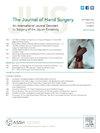Risk Factors for Failure of Nonsurgical Management of Ulnar Shaft Fractures
IF 2.1
2区 医学
Q2 ORTHOPEDICS
引用次数: 0
Abstract
Purpose
Isolated ulnar shaft fractures are frequently managed nonsurgically. However, rates of nonsurgical treatment failure remain substantial, and risk factors for the failure of nonsurgical management are not well described. This study investigated radiographic and patient-specific risk factors for the failure of nonsurgical management of isolated ulnar shaft fractures.
Methods
A retrospective review of patients with ulnar shaft fractures initially treated nonsurgically was performed at two tertiary referral centers over a 19-year period from 2001 to 2020. Patient- and injury-related variables, surgical interventions, and plain radiographic measurements were recorded. The outcome of interest was failure of nonsurgical management, defined as failure to achieve fracture union nonsurgically within 3 months of injury.
Results
One hundred fifty four patients initially treated nonsurgically for isolated ulnar shaft fractures were included. Twenty six patients (17%) experienced failure of nonsurgical management; these included five nonunions, 16 delayed unions, and 10 conversions to surgical management. Patients who experienced failure of nonsurgical management had a higher prevalence of diabetes mellitus, a higher employment rate, and fractures with higher initial median posteroanterior and lateral translations, fracture gap, and angulation; 83% of the patients with an initial fracture gap of ≥4 mm and 41% of the patients with an initial fracture angulation of >10° failed nonsurgical management.
Conclusions
Although most ulnar shaft fractures heal successfully with nonsurgical management, a substantial percentage of these fractures do not. Patients who are currently working, have diabetes mellitus, or have fractures with an initial fracture gap of ≥4 mm or an initial fracture angulation of > 10° may be more likely to fail nonsurgical treatment, although additional studies with larger sample sizes are needed to confirm these associations.
Type of study/level of evidence
Prognostic IV.
尺干骨折非手术治疗失败的危险因素。
目的:孤立性尺干骨折通常采用非手术治疗。然而,非手术治疗失败率仍然很高,非手术治疗失败的危险因素没有得到很好的描述。本研究探讨了孤立性尺干骨折非手术治疗失败的影像学和患者特异性危险因素。方法:回顾性分析2001年至2020年19年间在两个三级转诊中心进行非手术治疗的尺干骨折患者。记录患者和损伤相关变量、手术干预和x线平片测量。我们关注的结果是非手术治疗失败,定义为损伤后3个月内非手术治疗未能实现骨折愈合。结果:纳入了154例最初非手术治疗孤立性尺干骨折的患者。非手术治疗失败26例(17%);其中包括5例不愈合,16例延迟愈合,10例转手术治疗。非手术治疗失败的患者有较高的糖尿病患病率、较高的就业率、较高的骨折初始后前方中位和外侧平移、骨折间隙和成角;83%的初始骨折间隙≥4mm的患者和41%的初始骨折角度为bbb10°的患者非手术治疗失败。结论:尽管大多数尺干骨折在非手术治疗下成功愈合,但仍有相当比例的骨折不能治愈。目前正在工作、患有糖尿病或骨折初始骨折间隙≥4mm或初始骨折角度为bbb10°的患者可能更容易失败非手术治疗,尽管需要更多的更大样本量的研究来证实这些关联。研究类型/证据水平:预后IV。
本文章由计算机程序翻译,如有差异,请以英文原文为准。
求助全文
约1分钟内获得全文
求助全文
来源期刊
CiteScore
3.20
自引率
10.50%
发文量
402
审稿时长
12 weeks
期刊介绍:
The Journal of Hand Surgery publishes original, peer-reviewed articles related to the pathophysiology, diagnosis, and treatment of diseases and conditions of the upper extremity; these include both clinical and basic science studies, along with case reports. Special features include Review Articles (including Current Concepts and The Hand Surgery Landscape), Reviews of Books and Media, and Letters to the Editor.

 求助内容:
求助内容: 应助结果提醒方式:
应助结果提醒方式:


